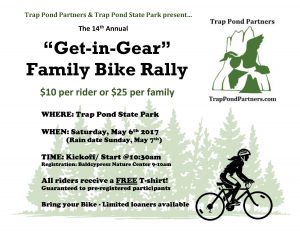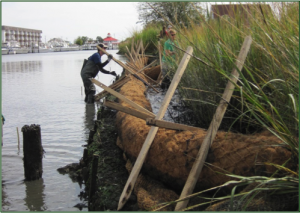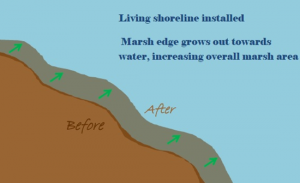
Facebook Twitter Instagram YouTube RSS Feed
Written on: March 15th, 2017 in Outreach
 Start American Wetlands Month off right with the 14th Annual Get in Gear Family Bike Rally and the inaugural Wetlands Celebration on Saturday, May 6th from 9am to 2pm at Trap Pond State Park in Laurel, Delaware. These two events have joined together to provide fun and engaging entertainment for the whole family that brings awareness to Delmarva’s wetlands and all the critters that call them home. If your interest is in science, art, or history or you just like to be active and outside, then this event is for you.
Start American Wetlands Month off right with the 14th Annual Get in Gear Family Bike Rally and the inaugural Wetlands Celebration on Saturday, May 6th from 9am to 2pm at Trap Pond State Park in Laurel, Delaware. These two events have joined together to provide fun and engaging entertainment for the whole family that brings awareness to Delmarva’s wetlands and all the critters that call them home. If your interest is in science, art, or history or you just like to be active and outside, then this event is for you.
The day kicks off with the Wetlands Celebration starting at 9 am with interactive activities, exhibitors, demos, music and live animals including horseshoe crabs, macroinvertebrates, geese, and even an opossum. Families will get the chance to take a wetland storybook walk, learn how to build a rain barrel, become a wetland scientist in the Volunteer Olympic Games, see a puppet show and more!
Multiple exhibitors will be present and include: Aquatic Resources Education Center, 3 Palms Zoo and Education Center, Ward Museum, Salisbury Zoo, Delaware Wild Lands, DNREC’s Wetland Monitoring and Assessment Program, Delaware National Estuarine Research Reserve, Delaware Division of Public Health, Nanticoke Watershed Alliance, and Trap Pond State Park.
Not to be forgotten are the free pontoon boat tours of Trap Pond that will take off every hour with the last one pulling out at 3:00pm and will give you a brief history of the pond and some of the plants and animals that call the place home. Are you the adventurous type? You can chart your own path and rent one of the park’s canoes and kayaks to go exploring on your own.
 If you prefer to travel around the park by land instead of sea, join the Family Bike Rally which is run by Trap Pond Partners, starts at 10:30 am and allows you to traverse the perimeter of Trap Pond using the power of your own two feet. Registration for the Bike Rally is $10 per person or $25 per family, and it is requested that you bring your own bike. All funds go to support Trap Pond State Park. Click here to sign up or for more information about becoming a sponsor.
If you prefer to travel around the park by land instead of sea, join the Family Bike Rally which is run by Trap Pond Partners, starts at 10:30 am and allows you to traverse the perimeter of Trap Pond using the power of your own two feet. Registration for the Bike Rally is $10 per person or $25 per family, and it is requested that you bring your own bike. All funds go to support Trap Pond State Park. Click here to sign up or for more information about becoming a sponsor.
Worried that you will be having too much fun, but there won’t be anything to eat? You’re covered with food trucks and vendors providing breakfast, lunch and dessert from Backyard Louies, Abbotts Grille, Hotdogs from the Beach and Ritas Italian Ice.
Park admission will be covered by the Bike Rally admission fee, or by being one of the first 150 cars to mention the Wetlands Celebration day at the fee booth! While you’re at the park, don’t forget to check out the trails or the Bald Cypress Nature Center to see all that Trap Pond State Park has to offer! This outdoor event is rain or shine, but some activities are weather permitting.
The Wetlands Celebration Event is supported by DNREC’s Wetland Monitoring and Assessment Program.
Written on: March 15th, 2017 in Living Shorelines
Living Shorelines Really Do Work!

PDE and DNREC work together to install a living shoreline along the eroding marsh edge next to the ball field in Lewes in 2014.
Tidal wetlands are incredible ecosystems that protect us and our properties from storm floods, provide habitat for fish and wildlife, clean our water, and store carbon from the atmosphere. When these wetlands are in good condition, they have the ability to keep up with sea level rise, allowing them to persist as water levels increase. Unfortunately, many tidal wetlands are in danger of disappearing because they are stressed, leaving them vulnerable to erosion and sea level rise. The good news is that scientists are developing new ways to prevent that from happening.
Traditionally, “hardened” or “gray” shorelines, such as breakwaters, bulkheads, and riprap, have been built upon stretches of shoreline to protect properties from wave energy and flooding. Hardened shorelines, however, can actually harm our coastlines. Waves bounce off of these hardened structures and reflect back out toward the water causing that wave’s energy to go to another location where it can still do damage. They also disconnect tidal marsh habitat from the water, which prevents wildlife from moving between the water and the marsh.
That’s where living shorelines come in; living shorelines are considered “softer” or “greener” shoreline protection methods because they incorporate natural materials, such as coir logs and oyster shell bags. They can benefit the wetland ecosystem and maintain the connection between the water and the marsh, while still providing protection to upland areas and preventing erosion of the shoreline.
Data that was recently collected from a living shoreline in Lewes, DE shows us just how effective living shorelines can be!

Analysis of data from a living shoreline in Lewes showed that the installation significantly extended the marsh edge towards the water. Increasing the marsh area can help stabilize eroding shorelines and help them face rising sea levels.
It was found that the Lewes living shoreline allowed the marsh edge to extend further out towards the water than it did before the installation. The project also significantly increased the height of the marsh, allowing it to support growth of smooth cordgrass (Spartina alterniflora) where it could not previously. The coir-fiber materials and shell bags that were used to construct the living shoreline did not degrade, showing that they are durable materials that can successfully be used in living shorelines projects.

Smooth cordgrass can only grow in the marsh at a certain height above water or else it might drown. The Lewes living shoreline created a higher elevation that supported growth of smooth cordgrass.
So, what do all of these results from the Lewes living shoreline project mean? The results show us that living shorelines really are effective at increasing the stability and ecological character of marsh edges in the face of erosion and sea level rise.
This means that they can be extremely helpful for protecting us and our properties against flooding and coastal storms, while also creating habitat for plants and wildlife! This is encouraging news that can help scientists, managers, and landowners further plan to protect our shorelines in ways that are both effective and more environmentally friendly than traditional hardened shorelines.
This project was a collaboration between our program (DNREC, Wetland Monitoring & Assessment) and the Partnership for the Delaware Estuary (PDE). To learn more about the Lewes project visit our previous blog post. Or you can dig into the data by clicking here for the full detailed report of results from the study.
Written on: March 15th, 2017 in Wetland Animals
Guest Writer: Amy Nazdrowicz, Landmark Science & Engineering
As residents of the Delmarva Peninsula, we are blessed with a high diversity of herpetofauna, (reptiles and amphibians), in part because of our landscape position which transitions between two physiographic regions: the coastal plain in its southern and central portions to the piedmont in the north. And no place showcases our herpetological diversity as our wetlands in springtime!
Whether you reside in the piedmont or coastal plain, the wetlands of the Delmarva Peninsula are a special place in the spring when the water tables tend to be at their highest and our herp species are becoming more active.
The raucous calls of our early breeding frogs, the Spring Peeper, Wood Frog, and New Jersey Chorus Frog, are a promise of the quickly approaching spring and the much appreciated sunshine that comes along with it.
But it’s a quieter harbinger that is an especially welcome sign of spring and lover of sunshine. The rare and beautiful Bog Turtle emerges along with the vegetation from a winter spent hibernating down in the muck or in subterranean tunnels surrounded by slowly flowing groundwater that provides protection from freezing. It is within a handful of our northern spring-fed wet meadows that the warm spring sunshine entices the Bog Turtle up to the surface to bask and prepare for breeding. I was once lucky enough to watch a male Bog Turtle emerge from a tunnel entrance among the roots of an Alder and blink into the sun, completely caked in mud accumulated during his winter hibernation. That was in early April but I have found Bog Turtles near the surface as early as March 20.
The Bog Turtles’ need for plenty of sunshine continues beyond the springtime into their breeding season where mating occurs on the wetland surface from approximately mid-April through mid-June. The summer sun remains important to gravid females during gestation and they lay their eggs in peak summer atop plant tussocks to fully absorb the sunshine.
Averaging only 3-4 inches in length, an adult Bog Turtle can fit into the palm of your hand. The hatchlings, breaking out of their eggs in late summer or early fall, are no larger than the size of a quarter.
Small, dark, and masters of camouflage, the only conspicuous identifying characteristic of a Bog Turtle is a sunny splash of yellow-orange coloration on each side of the head.
As plenty of sunshine is an important habitat component, crucial Bog Turtle habitat includes open, emergent wetlands with little to no tree canopy. And, as the Bog Turtle and their habitat are federally protected under the Endangered Species Act, Bog Turtle wetlands must sometimes be actively managed to keep ecological succession at bay and to maximize the sunlight reaching the wetland surface.
After a long winter, it is safe to say that humans and Bog Turtles alike are looking forward to the return of the springtime sunshine! Happy Spring and have fun exploring the wetlands of Delmarva!
Amy (Alsfeld) Nazdrowicz is an Environmental Scientist with Landmark Science & Engineering, a civil engineering firm providing civil/site design, surveying, GIS, and environmental consulting services. As a Recognized Qualified Bog Turtle Surveyor certified in Delaware, Maryland, and Pennsylvania, Amy and her Bog Turtle team conduct Phase I, II, and III Bog Turtle Investigations, as well as radio telemetry and other Bog Turtle monitoring services, throughout the region. Amy works from Landmark’s corporate headquarters in New Castle, DE and can be reached by phone at 302-323-9377 ext. 145, or by e-mail at amyn@landmark-se.com. Visit Landmark’s website for more information and services.